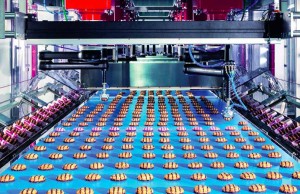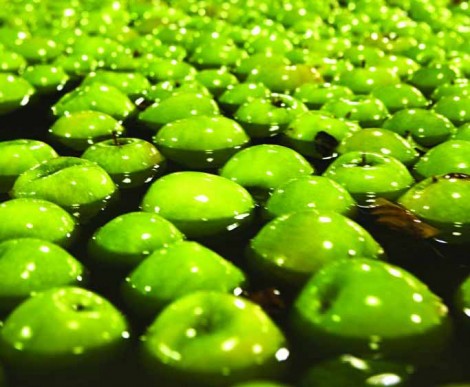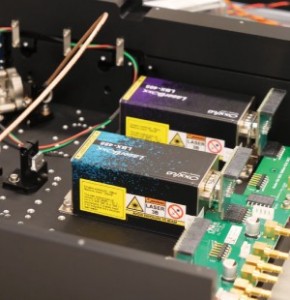
In recent years, there has been growing importance placed on issues of food safety and quality control. It is estimated that by 2025, the world’s population will exceed 8 billion people, with most growth occurring in developing countries. To meet the demands of this growing population, food supply will need to double, which puts an immense amount of pressure on the food industry as it works to keep up with the rising need for high-quality food.
Additionally, globalization and the increase in international trade is radically transforming the food industry. With food production spanning across borders, the supply chain has become increasingly complex and harder to trace. This shift has led to stricter government regulations on food safety, health, and traceability.
Fortunately, with the recent advancements in imaging technology, it is more cost-effective for the food processing industry to now invest in new technologies to ensure the safety and quality of our food. Historically, food inspection required trained human inspectors to perform visual screening operations. These trained inspectors scanned conveyor belts to identify and eliminate defective products – a relatively slow and inefficient process due to the limits of the human eye, human error, and fatigue. In addition to faster and more accurate inspection, some of today’s vision systems can also “see” below the surface of a product and find hidden or chemical defects not visible to the human eye. As a result, automated food sorting systems offer a much more efficient solution because they are able to more quickly and accurately filter out defective products that fail to meet quality standards.
Types and components of a food sorting system
Imaging systems, also referred to as optical sorters, have become the go-to solution for food inspection. This is because they can non-destructively inspect food products and maintain a level of objectivity that human vision simply cannot. Optical food sorting systems also have the ability to minimize waste and labor costs. Food sorting systems are generally segmented into free fall, belt, and lane systems. Free fall systems are particularly desirable for sorting seeds and grains, belt systems are mainly used for sorting prepared/preserved vegetables and fruits, and lane systems are mainly used to sort fresh produce. Irrespective of the food product being inspected, the majority of food sorting systems consist of four major components. The first component is the feed system. The feed system helps spread the produce evenly onto a conveyor belt, lane, or free-fall chute. From there, an optical system—which can consist of a color (visible), hyperspectral, or an x-ray imaging system—is strategically positioned either above or below the products being inspected, and it scans the products travelling through the chute or along the conveyor belt for defects. Third, image processing software compares the objects on the belt, lane, or chute to user-defined pass or fail thresholds to grade the moving objects.

These thresholds may be based on spectral, size, shape, or other specifics depending on the food type. Last, a separation system, which may take the form of compressed air for small produce or mechanical devices for larger objects, pinpoints defects and deflects, or redirects the items to a reject pile.
Typical foreign materials and food defects
Defects are typically categorized into two groups—visible and non-visible defects. Visible defects are defects that can easily be detected by the human eye. Some examples are discolorations, blemishes, broken or split objects, and objects that fail to meet a specific length, width, diameter, or area. Non-visible defects are those that cannot easily be detected by the human eye and might include soft, molded, or rotten foods, or foreign materials such as worms, snails, or small plastics, metals, and glasses, etc. that can find their way into food items. Usually, color imaging systems are used to spot visible defects, and hyperspectral imaging is able to reveal both visible and non-visible defects.
Color imaging systems
Color sorting is the main technology used today. Current food inspection systems used color imaging to detect defects on products moving across a conveyor belt. These imaging systems essentially see the same defects the human eye can see, but can do so faster and more objectively, maximizing throughput. By comparing the color of food items to some predetermined color criteria, these imaging systems can efficiently sort and grade food products. Color imaging systems are typically able to detect defects like blemishes or bruises, and ripeness or freshness levels for nuts, vegetables, fruit, meat and seafood. These imaging systems are also able to identify foreign materials like pieces of plastic and wood that may be present in a stream of produce.
Some of the technologies used in color imaging systems for food inspection today are three chip cameras and trilinear cameras. Three chip cameras make use of three separate charge-coupled devices (CCDs) or CMOS sensors, with each one receiving a separate red, green, or blue (RGB) color. As light comes into the lens, a prism-based beam-splitter separates the light into three different wavelength bands. A final color image is then reconstructed with the outputs generated from each of the three CCDs or CMOSs. This technology allows for the production of high quality color images with full physical resolution.
With trilinear cameras, like the Teledyne DALSA Piranha 4 Color RGB camera, a single sensor is equipped with three lines that are sensitive to red, green and blue respectively. Each of the three arrays captures one of the three colors simultaneously, but at slightly different locations as an object falls down a chute or moves across a conveyor belt. To form a full image, the camera must compensate for the spatial separation—also called spatial correction—by buffering the first and second arrays to match the third one.
Low-cost is a major requirement in food sorting. Teledyne DALSA is designing a new low-cost CMOS color sensor that is ideal for sorting applications.
Hyperspectral and multispectral imaging systems
Hyperspectral and multispectral imaging use more wavelength bands than just RGB color. Unlike trilinear cameras that divide light into only three arrays, hyperspectral imaging sensors collect data across hundreds of closely-spaced, narrow bands across the electromagnetic spectrum. Once these images are collected, they are combined to form an image cube that can be analyzed.
Hyperspectral imaging is particularly desirable for food inspection because of its ability to nondestructively test and determine the chemical and physical composition of a product. In the food industry, where defects may be present both on the surface and within a product, it is useful to have a system that can detect both internal and external defects. Different organic materials absorb light at different wavelengths across the electromagnetic spectrum based on their composition. This enables each material to have a specific “fingerprint” by which they can be identified. The user can specify accept/reject thresholds prior to inspection process, and from there, the hyperspectral imaging sorter will be able to use those fingerprints to sort products based on their chemical compositions. The ability of hyperspectral imaging to discriminate based on chemical composition is highly useful for sorting items that cannot simply be sorted based on physical characteristics like RGB color or shape. Also, certain contaminants like pieces of plastic, wood and mold cannot easily be identified with traditional imaging methods. Finally, hyperspectral imaging can help detect density differences, chlorophyll levels in produce, produce contaminated with toxins like aflatoxin, and help sort produce based on water content. Since all of these being invisible to the human eye, hyperspectral imaging serves as an excellent inspection system for the food industry.
However, hyperspectral imaging still faces challenges in terms of data processing capacity and cost. This method needs to process significant amounts of data in real time, which can be limited by computational power. That’s why multispectral imaging systems, like Teledyne DALSA’s Piranha 4 Multispectral 2k RGB+NIR Camera, which uses fewer bands and has been successfully adopted in food sorting applications.
In the new CMOS sensor family, Teledyne DALSA also plans to add a low-cost RGB+NIR multispectral sensor for the sorting applications.
X-Ray inspection systems
X-rays have long been associated with medical use, however they are increasingly being used in the food processing industry. X-rays are a form of electromagnetic radiation that is invisible. With short wavelengths, higher energies, x-rays can pass through most food products, making them an ideal nondestructive food inspection method. As an x-ray enters food, it loses some of its electromagnetic energy, and as it leaves the food product, the sensor in the inspection system is then able to convert the x-ray into a greyscale image that shows the interior of the food. Dense contaminants in a food product show up darker on the greyscale image, allowing for easy identification.
X-ray systems have many applications in the food inspection process such as detecting foreign materials like metals in baby food and inspecting product seals and packages. X-ray systems are also widely used for inspecting dried fruits, nuts, and seafood. Advanced x-ray systems can simultaneously perform in-line quality checks, measure the mass of a product, count products, identify missing or broken products, and monitor fill level. All of these features of x-ray make it a very cost-effective and efficient food inspection system.
While many consumers are concerned with their food being exposed to radiation, it is important to note that as food is inspected by an x-ray system, it usually does not spend more than a second in an x-ray beam, thus receiving a very low dose of radiation that is practically harmless. There is also concern for x-ray system operators being exposed to high amounts of radiation. Research has shown that under normal circumstances, operators who work with x-ray systems receive less radiation than that received in a year from natural background radiation, making it a relatively safe inspection method.
Inspection systems comply with regulations, meet customer expectations
As the food and beverage industry continues to face pressure to deliver higher quality and safer products, producers need to implement improved inspection and sorting systems to meet these standards. Additionally, the risk of a tarnished brand image in the face of a product recall is another reason that food producers seek out more reliable inspection systems that can guarantee a level of quality and confidence when it comes to detecting defective products. Considering all these factors, the use of advanced imaging technology for food inspection will continue to rise, as these systems enable producers to comply with tightening government regulations and the increasing expectations of consumers. One of the key requirements for food sorting is the system cost. Working with key customers in the market, Teledyne DALSA is currently in process of designing a completely new CMOS sensor family to meet the performance, volume, and cost requirements industry. Stay tuned to hear about new advances in food inspection as technology continues to evolve.
Written by Glen Ahearn, a Sales & Application Support Manager at Teledyne DALSA.































 Back to Features
Back to Features



























